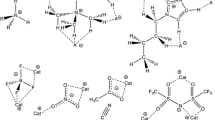Abstract
FOR dilute solid solutions of long-chain polar compounds in paraffins, it has been shown that the rotational transitions of the polar molecules from one position of minimum potential energy to another lead to dielectric absorption of the Debye type1,2. A theoretical study has also been made3,4 of the dielectric properties of pure crystalline compounds, in which dipolar interaction is an important factor.
Similar content being viewed by others
References
Jackson, W., Proc. Roy. Soc., A, 150, 197 (1935).
Fröhlich, H., Proc. Phys. Soc., 54, 422 (1942).
Fröhlich, H., and Sack, R., Proc. Roy. Soc., A, 182, 388 (1943–44).
Fröhlich, H., Proc. Roy. Soc., A, 185, 399 (1946).
Fröhlich, H., Trans. Farad. Soc., 42 A, 3 (1946).
Author information
Authors and Affiliations
Rights and permissions
About this article
Cite this article
MEAKINS, R. Dielectric Absorption in Crystalline Long-Chain Ketones. Nature 163, 840–841 (1949). https://doi.org/10.1038/163840b0
Issue Date:
DOI: https://doi.org/10.1038/163840b0
- Springer Nature Limited





